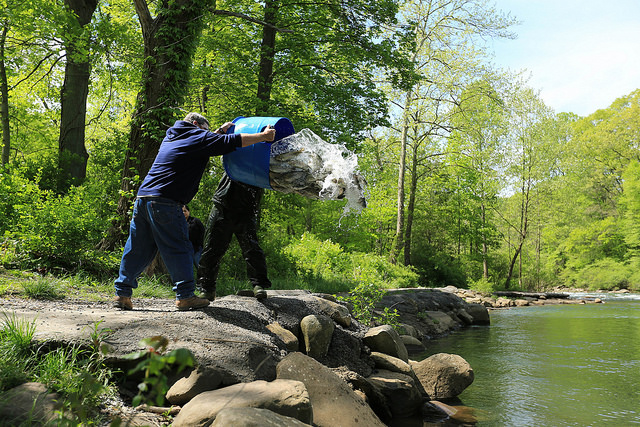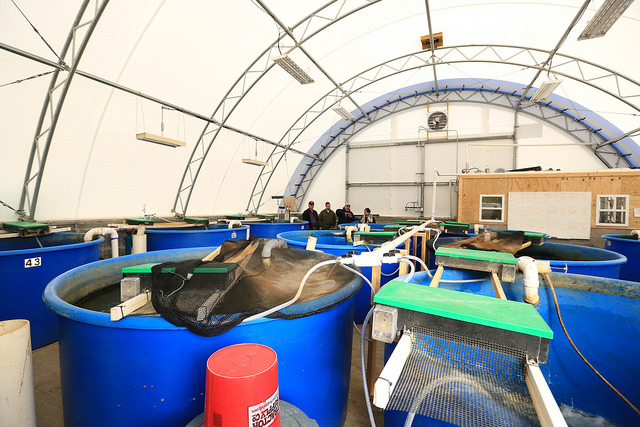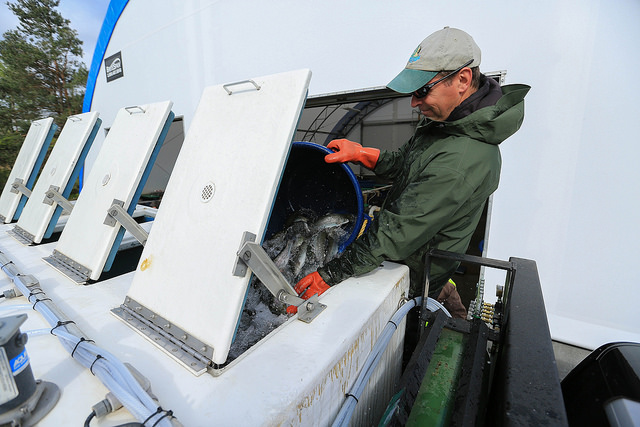Along the North Branch of the Potomac River, nestled between Garrett County, Maryland, and Mineral County, West Virginia, is Jennings Randolph Lake Dam (JRL). This flood risk management project was completed in 1981 by the U.S. Army Corps of Engineers, Baltimore District, and, since then, has provided not only flood control but water quality control, water supply, and recreation to the local area, while also attracting nature lovers looking for scenic and tranquil solitude.
Despite a full offering of water recreation activities, the tailwater section of the North Branch downstream of JRL is especially popular with anglers and fishermen. The area is recognized as a high-quality fishery and popular trophy trout destination, thanks in part to a long-standing partnership between the Corps and Maryland Department of Natural Resources (DNR).

DNR staff stock trout into the North Branch of the Potomac River, May 10, 2017. (U.S. Army photo by David Gray)
In order to better understand the current state of the area, it’s good to start at the struggles of the past.
North Branch History and Restoration
If you take a look back in history, you’ll quickly find the North Branch was not always the popular fishing destination it is today. Decades of pollution caused by acid mine drainage along with additional pollution resulting from the neighboring paper mill operation in Luke, Maryland, decimated the waterway’s aquatic life, rendering the upper North Branch “biologically dead for many decades," according to DNR’s website.
Mining in the North Branch of the Potomac began in the early 1800s. At that time, most mines were small underground operations that relied on gravity to drain water from work areas, sending large amounts of pollutants into nearby waterways. Acid mine drainage is characterized by low pH and high acidity, as well as high concentrations of sulfate and dissolved metals capable of devastating rivers, streams and aquatic life for decades. Unless properly mitigated, these early mining operations—most of which are now abandoned—continue discharging pollutants in perpetuity.
Initial recovery efforts from acid mine drainage pollution of the North Branch began in the early 1940s when Congress authorized the Interstate Commission on the Potomac River Basin, which is a federal, state and local government advisory agency formed in response to extreme pollution. In 1948, President Truman signed the Federal Water Pollution Control Act, the first major law enacted by Congress to address the problem of water pollution in the United States. Years later, the Water Quality Act of 1965 developed water quality standards for watersheds and waterways crossing state boundaries and created the Federal Water Pollution Control Agency to set standards in the absence of state action.
The completion of JRL in 1981 added a new element to the environmental restoration of the North Branch. 92,000 acre-feet of the 130,900 acre-feet of storage available at the project is dedicated to downstream water quality improvement. The dam allows for mixing of varying qualities of water from within the lake, leading to higher quality outputs into the North Branch. As a direct result of JRL’s improvements to water quality, DNR was able to initiate a trout restocking program downstream from the dam in the late 1980s. Trout thrived and grew rapidly.
Despite these improvements, waters flowing into the dam remained highly acidic.
By 1992, the Maryland Bureau of Mines began researching ways to mitigate the impacts of acid mine drainage on the North Branch upstream of JRL with hopes of improving lake water quality, which would lead to higher quality discharges from the dam. Their solution came in the form of quicklime, an affordable, dry chemical successfully used with a “doser,” or a machine that uses lime to neutralize acid. Beginning in 1993, lime dosers were placed at several sites along the North Branch. The system of dosers worked as intended, neutralizing acid and aiding in the restoration of water quality. A year later, DNR began a trout restocking program upstream of JRL, mirroring the program started in the 1980s downstream of the Corps project.
An Unlikely Partnership
Given the North Branch’s complicated history with the coal mining industry, it may come as a surprise that the largest controlled, cold-water source for potential trout rearing in Western Maryland today belongs to a coal mine—Mettiki Coal LLC, located in Garrett County, Maryland. In cooperation with DNR, Mettiki is using water from its acid mine drainage treatment plant to culture trout, supplying the state’s restocking program along the North Branch.
Millions of gallons of water flow out of Mettiki’s mine tunnels daily, which are then funneled into a collecting basin 600 feet underground where it is pumped to the surface and treated with lime to neutralize acid and remove other heavy metals. The resulting water quality is so good that in 1993, Mettiki approached DNR with a proposal for an experimental trout rearing program. DNR hesitantly agreed, delivering 200 rainbow trout, followed by another 200 brown trout a week later. The results were outstanding.
The project was the brainchild of Jim Ashby, Mettiki’s recently retired manager of Environmental Affairs. “I have been a trout fisherman all my life,” said Ashby. “I knew based on our studies that our water was consistently clean, with ideal oxygen levels and water temperatures. So why not raise trout?"
Decades later, Mettiki continues to play a part in restoration of the North Branch. In 2014, an upgraded bio-secure Mettiki Hatchery was completed, part of a cooperative agreement with DNR to culture trout directly in the shadow of Mettiki’s acid mine drainage treatment plan in Garrett County.
Mettiki Hatchery
The Mettiki Hatchery consists of twelve 1,000-gallon circular tanks used to grow out culture, along with two 210-gallon tanks used for hatching trout eggs. The hatchery’s water supply derives directly from Mettiki’s coal treatment plant clarifier. Supply water passes through a degassing and oxygenation system. Water then passes through an ultraviolet disinfection system before entering the hatchery.

Mettiki Hatchery, located in Garrett County, Maryland, is operated by DNR and funded by Mettiki Coal, LLC. (U.S. Army photo by David Gray)
The hatchery purchases more than 25,000 trout eggs twice a year, in June and December, for their production cycle. Eggs spend two months in the hatch system before being transferred to larger tanks. The entire process takes approximately nine months from beginning to end, until fish are approximately 10-12 inches long and ready for North Branch restocking.
From these hatches, DNR personnel produce and stock approximately 20,000 adult rainbow trout during the spring “Put and Take” stocking season, as well as 15,000 adult rainbow trout during the fall stocking program. Approximately 15,000 surplus fingerling are stocked as “Put and Grow” production into designated streams in western Maryland. According to DNR’s website, “an additional 10 percent of the trout are cultured to trophy size to provide anglers the opportunity to catch some spectacular fish.”
DNR supplies the feed required to maintain the hatchery and pays for its employees’ salaries. The hatchery’s infrastructure and construction were funded completely by Mettiki. They also cover all of the facility’s monthly rotating expenses.
Restocking the North Branch
The fish restocking process relies heavily on manual labor.
DNR staff removes fish from hatchery tanks with nets, and places them into plastic tubs that weigh approximately 150 pounds when filled. The buckets are then hand-carried to a stocking vehicle equipped with four individual compartment tanks, each with its own fresh-flow aerator. Additional oxygen is also injected into each tank during the stocking process.

DNR staff places trout into a stocking vehicle in preparation for North Branch stocking, May 10, 2017. (U.S. Army photo by David Gray)
The stocking vehicle proceeds to make pre-scheduled stops along various waterways, which are made available to the public by DNR on their website. Local volunteers often join DNR staff during their stocking runs, many bringing their fishing poles along to reap the benefits of their labor once stocking is complete.
Maintaining a Trophy-Class Trout Stream
After decades of recovery efforts, the Corps and DNR remain committed on assuring the North Branch maintains its reputation as one of the finest trout fisheries in the east, both upstream and downstream of JRL.
“The Army Corps of Engineers allows us to turn this river back into a trout stream,” said Jody Johnson, DNR District fish biologist for Garrett and Alleghany counties. “Together, we’re working for the fisherman, trying to increase the amount of fishing opportunities whenever we can.”
Tom Craig, Corps JRL park ranger, agrees.
“The Corps and DNR work together to form our water quality mission by letting out high-quality, cold water that not only helps DNR stock trout, but also helps us with recreation,” said Craig. “Without this partnership, we wouldn’t have the successful trout steam that we do today.”